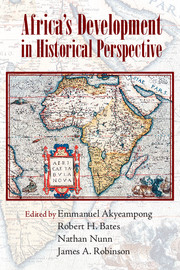Book contents
- Frontmatter
- Contents
- Author Biographies
- Acknowledgments
- Introduction
- Part I La Longue Durée
- Part II Culture, Entrepreneurship, and Development
- 5 Redistributive Pressures in Sub-Saharan Africa: Causes, Consequences, and Coping Strategies
- 6 Accumulation and Conspicuous Consumption: The Poverty of Entrepreneurship in Western Nigeria, ca. 1850–1930
- 7 Commerce, Credit, and Mobility in Late Nineteenth-Century Gold Coast: Changing Dynamics in Euro-African Trade
- 8 The Textile Industry of Eastern Africa in the Longue Durée
- 9 Explaining and Evaluating the Cash Crop Revolution in the “Peasant” Colonies of Tropical Africa, ca. 1890–ca.1930: Beyond “Vent for Surplus”
- 10 Reinventing the Wheel: The Economic Benefits of Wheeled Transportation in Early Colonial British West Africa
- 11 Mbanza Kongo/São Salvador: Culture and the Transformation of an African City, 1491 to 1670s
- Part III Institutions
- Part IV External Forces
- Index
- References
8 - The Textile Industry of Eastern Africa in the Longue Durée
Published online by Cambridge University Press: 05 September 2014
- Frontmatter
- Contents
- Author Biographies
- Acknowledgments
- Introduction
- Part I La Longue Durée
- Part II Culture, Entrepreneurship, and Development
- 5 Redistributive Pressures in Sub-Saharan Africa: Causes, Consequences, and Coping Strategies
- 6 Accumulation and Conspicuous Consumption: The Poverty of Entrepreneurship in Western Nigeria, ca. 1850–1930
- 7 Commerce, Credit, and Mobility in Late Nineteenth-Century Gold Coast: Changing Dynamics in Euro-African Trade
- 8 The Textile Industry of Eastern Africa in the Longue Durée
- 9 Explaining and Evaluating the Cash Crop Revolution in the “Peasant” Colonies of Tropical Africa, ca. 1890–ca.1930: Beyond “Vent for Surplus”
- 10 Reinventing the Wheel: The Economic Benefits of Wheeled Transportation in Early Colonial British West Africa
- 11 Mbanza Kongo/São Salvador: Culture and the Transformation of an African City, 1491 to 1670s
- Part III Institutions
- Part IV External Forces
- Index
- References
Summary
Introduction
Historians are divided over the issue of the role of textiles in the economic development of eastern Africa, defined here as stretching from the Sudan to South Africa. Ravi Palat and Immanuel Wallerstein claim that India “deindustrialized” its Indian Ocean periphery by exploiting advanced textile techniques and cheap labor (Palat and Wallerstein 1999, 36–7). Similarly, John Mack and Pedro Machado contend that Indian imports fatally undermined a fragile textile sector in eastern Africa, long before Lancashire and New England cottons flooded in from the mid-nineteenth century (Machado 2005, 91–151, 2009, 167; Mack 1993, 303–4). Michael Pearson recognizes that Indian cloth penetrated deep into the markets of early modern eastern Africa, but he poses a crucial counterfactual question: Would the performance of African textiles have been better or worse without imports from South Asia? (Pearson 1998, 121–2).
The fact that textile production grew in South Asia’s oceanic periphery from the mid-seventeenth to the mid-nineteenth century, including in eastern Africa, argues against the position adopted by Palat, Wallerstein, Mack, and Machado. Trade proved to have generally positive rather than negative consequences. While locally produced cloth was only episodically competitive overseas, it had substantial internal markets in Africa. South Asian artisans emigrated little, but they provided models to imitate. Specialized trade diasporas, often South Asian in composition, supplied information, credit, shipping, commercial facilities, and intermediate goods for further transformation, such as colored yarn and plain cloth (Clarence-Smith 2009, 2011). Thus eastern Africa was not a captive market for South Asia, but rather a partner in the development of textile production.
- Type
- Chapter
- Information
- Africa's Development in Historical Perspective , pp. 264 - 294Publisher: Cambridge University PressPrint publication year: 2014
References
- 9
- Cited by



